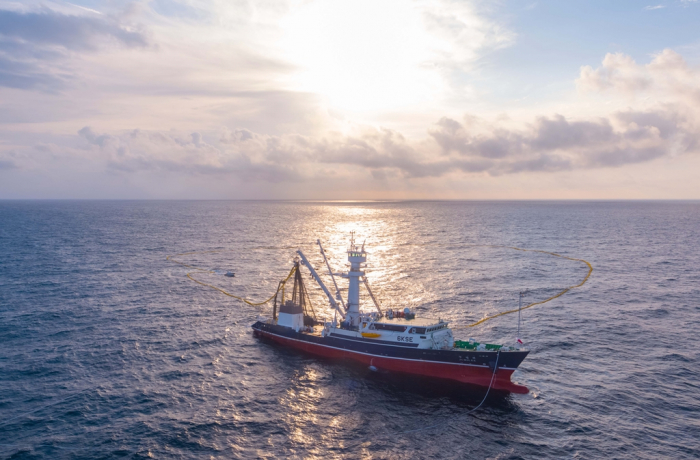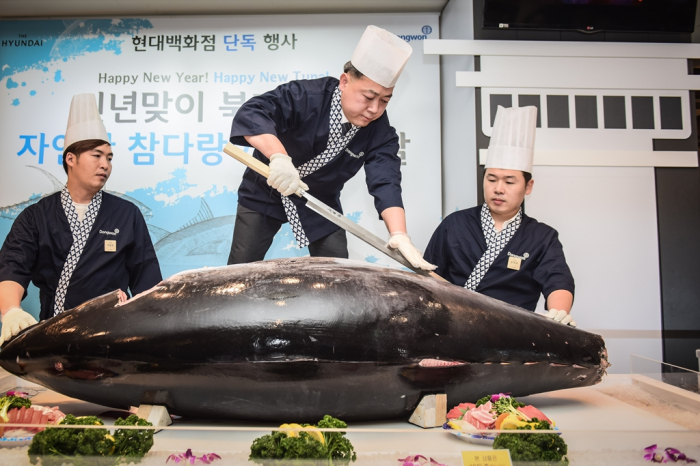Food & Beverage
Drones, AI, big data power Korean fisheries’ earnings
Dongwon now fishes tuna for sashimi using high-tech on ships before used for canned fish; Silla, Sajo also look to sashimi
By Aug 17, 2022 (Gmt+09:00)
2
Min read
Most Read
LG Chem to sell water filter business to Glenwood PE for $692 million


KT&G eyes overseas M&A after rejecting activist fund's offer


Mirae Asset to be named Korea Post’s core real estate fund operator


StockX in merger talks with Naver’s online reseller Kream


Meritz backs half of ex-manager’s $210 mn hedge fund



The Jubilee, a 2,200-ton tuna fishing vessel operated by South Korea’s leading fishing company Dongwon Industries Co., has been using drones to detect fish shoals since 2019. The artificial intelligence drones -- worth about 400 million won ($304,530) per unit -- can learn big data from natural signals such as wave changes to detect schools of tuna.
Dongwon has spent a total of 200 billion won applying high-tech to its fleets since 2014. The investment is now bearing fruit, with the company posting record profit in the second quarter of 2022. Its smaller rivals such as Silla Co. and Sajo Industries Co. also logged strong profits during the period.
Dongwon’s operating profit and sales jumped 59% and 29.8%, respectively, in the second quarter from a year earlier. Silla enjoyed 193% and 61.7% surges in profit and revenue during the period, while Sajo reported 82.7% and 37.4% growth, respectively.
Such healthy earnings came on a rise in the tuna catch during the April-June period. Tuna is sensitive to water temperature and colder water usually drives the fish deep into the sea, making it difficult to form a fishing ground. Water temperatures in the Pacific Ocean rose in the second quarter, helping tuna to flock.
Demand for expensive fish such as tuna and salmon has surged of late, while sales prices of raw tuna sharply rose. The average prices of raw tuna for processing sold by the three fishing companies soared 40.2% so far this year.
SASHIMI MORE PROFITABLE
The industry has been improving productivity through investment in vessels and innovating the fishing process to raise tuna prices. The sector developed technologies to fish tuna for sashimi, which is more valuable, for use on purse seiners that usually fish tuna for canned goods.
“Tuna for sashimi is over 10 times more expensive than tuna for canned goods on a raw tuna basis,” said a Dongwon official. “We are producing tuna for sashimi with purse seiners through improvement in the cooling catch process.”

Silla and Sajo are also looking to continuously increase their production of tuna for sashimi, which is more profitable.
Dongwon has been focusing on the modernization of its vessel fleets. The company has invested 200 billion won since 2014 to build six new purse seiners. It plans to install the AI drones on another ship this year.
“The drones also help us cut fuel consumption, replacing helicopters that we used before to detect distant fish shoals,” said the official.
Fuel prices usually account for about 30% of the total costs of raw tuna fishing.
Dongwon was relatively immune to the recent global supply chain disruption as it operates five of its own carriers to transport fishery products caught from deep-sea fishing vessels to key sales markets.
“We secured much better cost competitiveness in terms of freight rates compared to other companies as we operate our own carriers,” said the official.
Write to Kyeong-je Han at hankyung@hankyung.com
Jongwoo Cheon edited this article.
More to Read
-
 Corporate restructuringDongwon Industries becomes new holding firm of seafood conglomerate
Corporate restructuringDongwon Industries becomes new holding firm of seafood conglomerateApr 08, 2022 (Gmt+09:00)
3 Min read -
 Food & BeverageDongwon aims to rise from canned tuna maker to F&B giant
Food & BeverageDongwon aims to rise from canned tuna maker to F&B giantSep 16, 2021 (Gmt+09:00)
2 Min read
Comment 0
LOG IN


